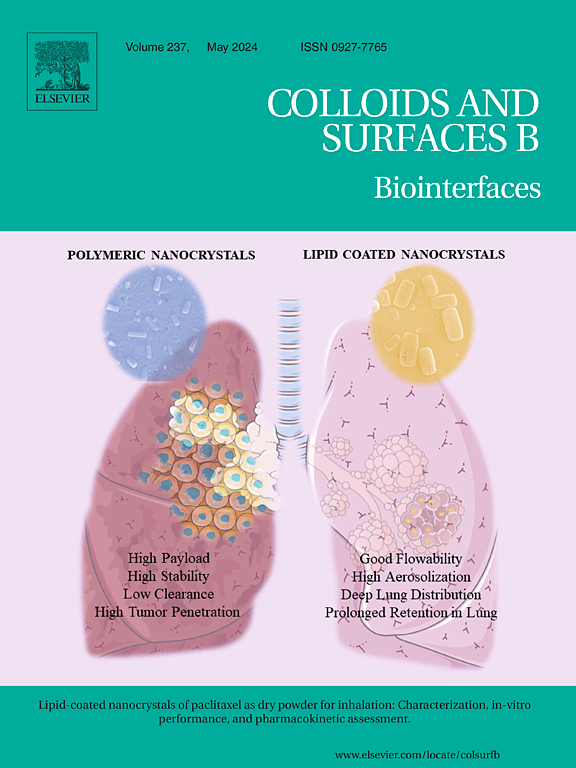基于无定形碳酸钙构建的 "溶酶体炸弹",通过放大声动力疗法诱导肿瘤凋亡。
IF 5.4
2区 医学
Q1 BIOPHYSICS
引用次数: 0
摘要
恶性肿瘤的酸性性质会导致药物螯合和逃避凋亡损伤,而肿瘤细胞溶酶体的异常又会进一步加剧这种情况。本研究将利用一种酸中和的无定形碳酸钙(ACC)来包裹声纳增敏剂原卟啉IX(PpIX),然后在其上包覆同源的肿瘤细胞膜,以增加水溶性和同源靶向性,从而构建一种 "溶酶体炸弹"。本文设计的 PpIX-ACC@CMs 为爆米花状结构,不仅能中和肿瘤酸性微环境,平衡 pH 值,释放多余 Ca2+,还能引起溶酶体功能紊乱,实现药物溶酶体逃逸,增加药物蓄积。此外,ACC 酸性反应产生的二氧化碳气核还能增加超声空化效应,从而放大声动力疗法(SDT)的效果。体外和体内实验表明,作为 "溶酶体炸弹 "的 PpIX-ACC@CMs 成功定位于肿瘤细胞的溶酶体,并通过其酸性反应能力表现出溶酶体逃逸能力,在超声波刺激下实现了良好的 SDT 疗效。此外,外源性 Ca2+ 过载也增加了肿瘤钙化的可能性,这有助于体内肿瘤抑制,并有助于 CT 医学成像监测治疗效果。本文章由计算机程序翻译,如有差异,请以英文原文为准。
A "lysosomal bomb" constructed based on amorphous calcium carbonate to induce tumor apoptosis by amplified sonodynamic therapy
The acidic nature of malignant tumors leads to increased drug sequestration and the evasion of apoptotic damage, which is further exacerbated by abnormal lysosomes in tumor cells. In this study, a "lysosomal bomb" will be constructed using a type of acid-neutralized amorphous calcium carbonate (ACC) to encapsulate the sonosensitizer protoporphyrin IX (PpIX), and then coated with homologous tumor cell membranes to increase water solubility and homologous targeting. The PpIX-ACC@CMs designed in this paper are popcorn-like structures, which can not only neutralize the tumor's acidic microenvironment to balance the pH value and release excess Ca2+, but also cause lysosomal dysfunction and achieve drug lysosomal escape to increase drug accumulation. Additionally, the CO2 gas nucleus produced by the acid reaction of ACC can increase the ultrasonic cavitation effect to amplify the sonodynamic therapy (SDT) effect. In vitro and in vivo experiments demonstrated that PpIX-ACC@CMs, serving as a "lysosomal bomb," successfully localized to lysosomes of tumor cells and exhibited lysosomal escape ability through its acid reaction ability, achieving excellent SDT efficacy under ultrasound stimulation. Furthermore, exogenous Ca2+ overload also increased the likelihood of tumor calcification, which could contribute to in vivo tumor inhibition and facilitate CT medical imaging to monitor treatment efficacy.
求助全文
通过发布文献求助,成功后即可免费获取论文全文。
去求助
来源期刊

Colloids and Surfaces B: Biointerfaces
生物-材料科学:生物材料
CiteScore
11.10
自引率
3.40%
发文量
730
审稿时长
42 days
期刊介绍:
Colloids and Surfaces B: Biointerfaces is an international journal devoted to fundamental and applied research on colloid and interfacial phenomena in relation to systems of biological origin, having particular relevance to the medical, pharmaceutical, biotechnological, food and cosmetic fields.
Submissions that: (1) deal solely with biological phenomena and do not describe the physico-chemical or colloid-chemical background and/or mechanism of the phenomena, and (2) deal solely with colloid/interfacial phenomena and do not have appropriate biological content or relevance, are outside the scope of the journal and will not be considered for publication.
The journal publishes regular research papers, reviews, short communications and invited perspective articles, called BioInterface Perspectives. The BioInterface Perspective provide researchers the opportunity to review their own work, as well as provide insight into the work of others that inspired and influenced the author. Regular articles should have a maximum total length of 6,000 words. In addition, a (combined) maximum of 8 normal-sized figures and/or tables is allowed (so for instance 3 tables and 5 figures). For multiple-panel figures each set of two panels equates to one figure. Short communications should not exceed half of the above. It is required to give on the article cover page a short statistical summary of the article listing the total number of words and tables/figures.
 求助内容:
求助内容: 应助结果提醒方式:
应助结果提醒方式:


